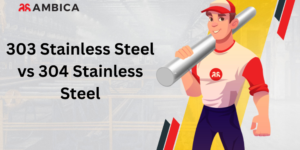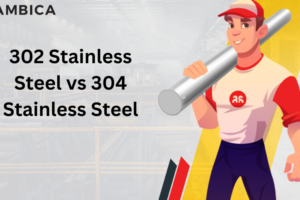 Stainless steel is a lifeline of major industries, it has an excellent characteristic of strength, corrosion resistance and good looks at the same time. Among the multitude of stainless steel grades available, two stand out prominently: Stainless Steel grade 303 and Stainless Steel 304. Even though they have some features in common, they also show peculiarities that make them well-suited for specific applications.
Stainless steel is a lifeline of major industries, it has an excellent characteristic of strength, corrosion resistance and good looks at the same time. Among the multitude of stainless steel grades available, two stand out prominently: Stainless Steel grade 303 and Stainless Steel 304. Even though they have some features in common, they also show peculiarities that make them well-suited for specific applications.
This article will uncover the chemical composition, properties, and applications of SS 303 and SS 304.
The difference between 303 and 304 stainless steel
At first sight, 303 and 304 stainless steel might look alike, but they differ in both their composition and characteristics. Let’s break down these disparities:
Composition:
303 Stainless Steel: This grade is supplemented with sulfur and phosphorus, which enhance its machinability. Sulfur contributes to the chipping of the material during the machining while phosphorus improves machinability without facing corrosion.
C – 0-0.10%
Mn – 0-2.0%
Si – 0-1.0%
P – 0-0.4%
S – 0-0.15%
Cr – 17-19%
Ni – 8-10%
Fe – balance
304 Stainless Steel: Unlike 303, 304 stainless steel does not have sulfur and phosphorus additives in it. Rather, it is mainly made of chromium and nickel, with the manganese and other elements present in smaller amounts. This gives 304 better corrosion resistance and weldability compared with 303.
C – .08%
Mn – 2%
Si – .75%
P – .045%
S – .03%
Cr – 18-20%
Ni – 8 – 10.5%
N – .10%
Machinability:
303 Stainless Steel: Owing to sulfur and phosphorus, 303 stainless steel has high machinability and can be cut, drilled and machined easily.
304 Stainless Steel: 304 stainless steel is machinable, but it is not as easy to machine as 303 due to its higher nickel content. Nevertheless, with proper tools and techniques, 304 machining is still possible.
Corrosion Resistance:
303 Stainless Steel: While 303 stainless steel offers a good level of corrosion resistance in neutral environments, it is not as corrosion-resistant as 304 stainless steel is. Thus, it might not be suitable for an application which is subjected to an aggressive corrosive environment.
304 Stainless Steel: The 304 stainless steel has been recognized for its outstanding corrosion resistance and has become the preferred option for applications that are sensitive to moisture, chemicals, or salt water.
Durability Difference
The uniqueness of stainless steel and its durability are the main factors that determine how suitable it will be for different purposes. In terms of durability:
303 Stainless Steel: Even though 303 stainless steel is tough and offers a decent degree of wear and tear resistance, it might get corroded more quickly than 304 stainless steel in corrosive environments.
304 Stainless Steel: Although the 304 stainless steel may be harder to weld, its high chromium content gives it superior durability and corrosion resistance, hence it is applicable in food processing, chemicals and engineering in the marine industry.
Usability Difference
303 Stainless Steel: The sulfur and phosphorous composition of 303 stainless steel make it extremely easy to machine, which is why it is a go-to choice for applications that require extensive machining operations, such as high-precision components and fasteners.
304 Stainless Steel: Even though its machinability is not as high as 303, 304 stainless steel still has high weldability and formability, thus it can be made into various parts and structures. Its versatility makes it fit for many kinds of processes in different industries.
Cost Difference
303 Stainless Steel: 303 stainless steel is cheaper than 304 because of its low nickel content and simpler composition which make it more affordable.
304 Stainless Steel: Although it is relatively more expensive than 303, 304 stainless steel has better corrosion-resisting capability and versatility, which will make it a sensible choice in many applications shortly.
What Are The Most Common Applications For 303 And 304 Stainless Steel?
This knowledge of where 303 and 304 stainless steel are used at their best is critical for better choice-making. Let’s explore some of the most common applications for each grade:
Grade 303 Applications:
- Machined Components: Generating parts with high precision such as shafts, bolts, and nuts.
- Fasteners: Manufacturing of screws, nuts and bolts used in the automotive, aircraft and machinery sector.
- Valve and Pump Components: Manufacturing of fittings, and shafts for valves in fluid systems.
Grade 304 Applications:
- Food Processing Equipment: Manufacturing equipment including pipes, tanks, and storage containers.
- Architectural Structures: Architectural usage in building facades, handrails and decorative pieces.
- 3. Marine Environments: In marine applications like installation in boats or boats’ fittings, marine hardware, and offshore platforms.



